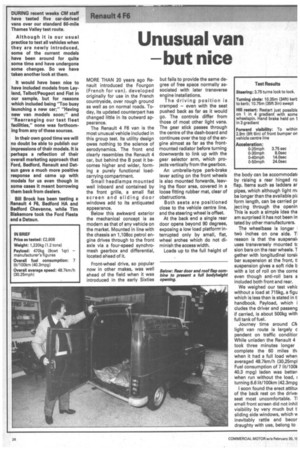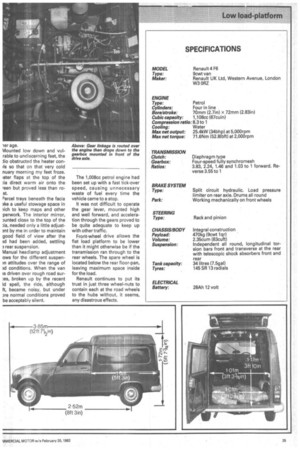Unusual van but nice
Page 18

Page 19

If you've noticed an error in this article please click here to report it so we can fix it.
MORE THAN 20 years ago Renault introduced the Fourgon (French for van), developed originally for use in the French countryside, over rough ground as well as on normal roads. Today, its updated counterpart has changed little in its outward appearance.
The Renault 4 F6 van is the most unusual vehicle included in this group test. Its utility design awes nothing to the science of aerodynamics. The front end clearly resembles the Renault 4 car, but behind the B post it becomes higher and wider, forming a purely functional loadcarrying compartment.
Small headlamps mounted well inboard and contained by the front grille, a small flat screen and sliding door windows add to its antiquated appearance.
Below this awkward exterior the mechanical concept is as modern as that of any vehicle on the market. Mounted in line with the chassis an 1,108cc petrol engine drives through to the front axle via a four-speed synchromesh gearbox and differential, located ahead of it.
Front-wheel drive, so popular now in other makes, was well ahead of the field when it was introduced in the early Sixties but fails to provide the same degree of free space normally associated with later transverse engine installations.
The driving position is cramped — even with the seat pushed back as far as it would go. The controls differ from those of most other light vans. The gear stick passes through the centre of the dash-board and continues over the top of the engine almost as far as the frontmounted radiator before turning downwards to link up with the gear selector arm, which projects vertically from the gearbox.
An umbrella-type park-brake lever acting on the front wheels is also mounted forwards, leaving the floor area, covered in a loose fitting rubber mat, clear of obstructions.
Both seats are positioned close to the vehicle centre line, and the steering wheel is offset.
At the back end a single rear door opens beyond 90 degrees, exposing a low load platform-interrupted only by small, flat, wheel arches which do not diminish the access width.
Loads up to the full height of the body can be accommodati by raising a rear hinged ro flap. Items such as ladders ar pipes, which although light mi be longer than the available ph form length, can be carried pr jecting through the openin This is such a simple idea tha am surprised it has not been in teted by other manufacturers.
The wheelbase is longer I two inches on one side. TI reason is that the suspensii uses transversely mounted tc sion bars on the rear wheels. T gether with longitudinal tusk bar suspension at the front, ti suspension gives a soft ride b with a lot of roll on the come even though anti-roll bars a included both front and rear.
We weighed our test vehic without a load at 715kg, a figu which is less than is stated in tl handbook. Payload, which i dudes the driver and passeng if carried, is about 500kg with full tank of fuel.
Journey time around Old light van route is largely c pendent on traffic conditior While unladen the Renault 4 took three minutes longer complete the 60 miles th, when it had a full load when averaged 48.7km/h (30.25mpl Fuel consumption of 7 lit/100k 40.3 mpg} laden was better' when run without the load, turning 6.6 lit/100km (42,3mpg
I soon found the erect attitus of the back rest on the drivel seat most uncomfortable. TI small front screen did not inhil visibility by very much but t' sliding side windows, which IA inevitably rattle and becor draughty with use, belong to
-ler age.
Mounted low down and vulrable to undiscerning feet, the iio obstructed the heater con Is that on that very cold nuary morning my feet froze. .ater flaps at the top of the !ia direct warm air onto the reen but proved less than rost.
Parcel trays beneath the facia aka a useful stowage space in lich to keep maps and other perwork. The interior mirror, aunted close to the top of the needed only a little adjust?At by me in order to maintain good field of view after the ad had been added, settling a rear suspension.
Manual headlamp adjustment ows for the different suspen)n attitudes over the range of ad conditions. When the van is driven over rough road surms, broken up by the recent Id spell, the ride, although ft, became noisy, but under )re normal conditions proved be acceptably silent. The 1,008cc petrol engine had been set up with a fast tick-over speed, causing unnecessary waste of fuel every time the vehicle came to a stop.
It was not difficult to operate the gear lever, mounted high and well forward, and acceleration through the gears proved to be quite adequate to keep up with other traffic.
Front-wheel drive allows the flat load platform to be lower than it might otherwise be if the transmission ran through to the rear wheels. The spare wheel is located below the rear floor-pan, leaving maximum space inside for the load.
Renault continues to put its trust in just three wheel-nuts to contain each at the road wheels to the hubs without, it seems, any disastrous effects.


















































